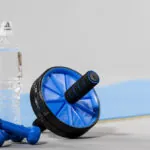A yoga ball, also known as a stability ball or exercise ball, is a versatile piece of equipment that can enhance your yoga practice by improving balance, core strength, and overall fitness. Using a yoga ball in your routine can introduce new challenges, help you deepen stretches, and add an element of fun to your workouts. Here’s how to effectively use a yoga ball in your yoga practice.
Benefits of using a yoga ball
- Enhanced core strength: Engaging your core muscles is essential when maintaining balance on the unstable surface of the ball, which can lead to improved core strength and stability.
- Improved balance and coordination: Regular use of a yoga ball helps develop your balance and coordination, as you need to constantly adjust your body to maintain stability. Improving these two features will help you get better at yoga. See what else you need and how long it takes to boost your yoga proficiency.
- Increased muscle engagement: Performing yoga poses on a yoga ball involves more muscles than the same poses done on a stable surface, enhancing muscle engagement and strength.
- Deepened stretches: The ball can be used to support the back, hips, or legs, allowing you to safely deepen stretches and increase your flexibility.
Also known as fitness ball, this exercise accessory is great for seniors for its low-impact nature. Check out these seven easy fitness ball exercises for seniors.
How to use a yoga ball
Here are a few ways you can use a yoga ball:
For balance and core strengthening
Example: Ball plank. Place your hands on the yoga ball instead of the floor when performing a plank. The instability of the ball forces your core to work harder to maintain your balance.
For stretching and flexibility
Example: Back stretch. Sit on the yoga ball, slowly walk your feet forward, and roll the ball under your back until it reaches the upper back, then gently extend your arms overhead and arch your back over the ball for a deep stretch.
For strengthening exercises
Example: Wall squats. Place the yoga ball between your lower back and the wall. Lean against the ball, and perform squats. The ball rolls up and down smoothly with your movements, providing support for your back while strengthening the thighs and glutes.
For advanced yoga poses
Example: Bridge pose. Lie on your back with your feet placed on top of the yoga ball. Lift your hips to form a bridge, engaging your glutes and hamstrings. The ball’s instability increases the difficulty and effectiveness of the pose.
If you need more guidance, don’t hesitate to join our yoga classes in Lake City.
Tips for using a yoga ball safely
- Choose the right size: The size of the ball should match your height. When sitting on the ball, your knees should be at a right angle with your thighs parallel to the ground.
- Ensure proper inflation: Inflate the ball according to the manufacturer’s instructions so it is firm enough to support your weight but has enough give to be comfortable.
- Use a non-slip surface: Place the ball on a yoga mat or another non-slip surface to prevent it from sliding, which could cause falls or injuries.
- Start slowly: Begin with basic exercises to get used to the ball’s movement and feel. As you become more comfortable, gradually incorporate more challenging poses.
- Focus on form: Pay close attention to your form to ensure you are performing exercises correctly and safely. Poor form on an unstable surface like a yoga ball can lead to injuries.
Final thoughts
Using a yoga ball in your practice can significantly enhance physical health benefits such as core strength, balance, flexibility, and overall muscle tone. With careful practice and attention to safety, a yoga ball can be a fun and challenging addition to your yoga routine, offering new ways to explore and deepen your practice.





